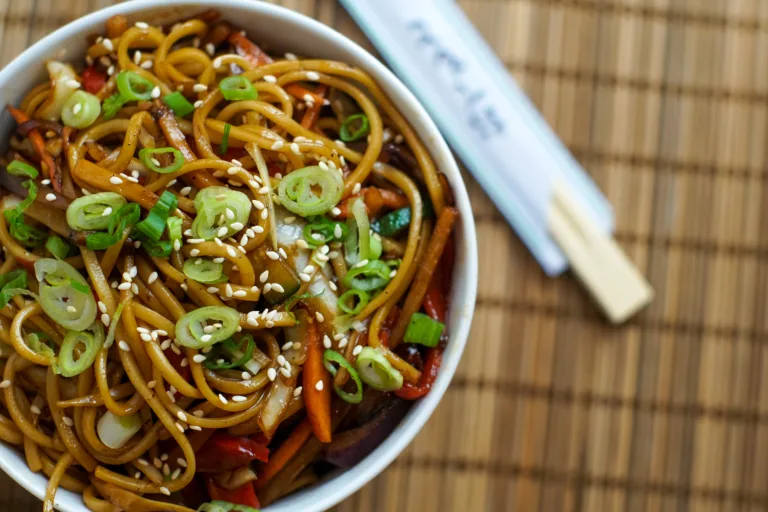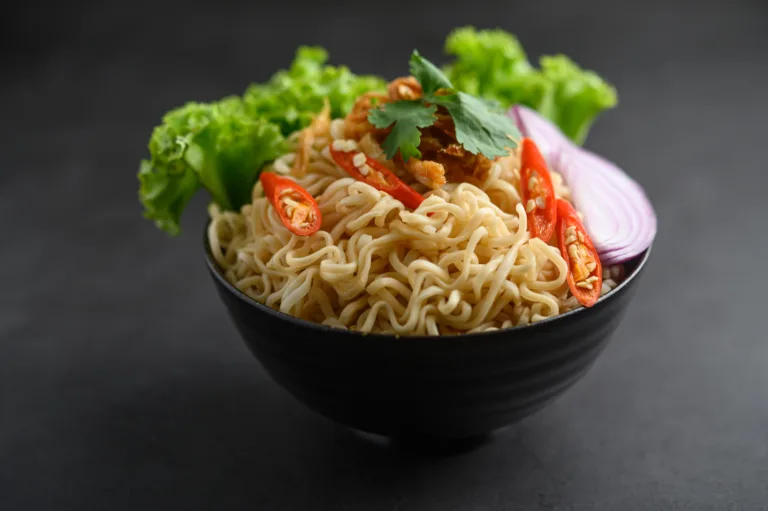
VEGETABLE Pan-fried food NOODLES RECIPE
On the off chance that you’re searching for a speedy and simple weeknight supper, this vegetable sautéed food noodles recipe is great. It’s loaded with vegetables and is staggeringly fulfilling. What is pan-searing?
Stir-frying is an adept culinary method that calls for a rapid-fire approach of combining ingredients, typically consisting of both vegetables and protein, in a blistering wok or skillet alongside a modest amount of oil, all over a blazing I inferno.
Vegetable Pan fried food Noodles Recipe
To ensure that the contents are evenly cooked and do not adhere or char, the ingredients must be incessantly tossed and agitated.
Through the utilization of this technique, delectable and crisp ingredients, while maintaining their intrinsic nutrients and innate hues, can be obtained.
Stir-frying is frequently employed within the bounds of Asian cuisine and is an exceedingly multifaceted approach that offers an extensive scope of ingredients and flavor profiles.
For the stir-fry sauce you need
Soy sauce: The condiment that imparts a salty, savory, and umami taste to the stir-fry sauce, which is typical in the culinary culture of Asia. If one is concerned with gluten, tamari must be used instead to make a gluten-free stir-fry sauce.
Rice vinegar: The sour substance enhances the acidity and harmonizes the homemade sauce.
Maple syrup: The natural sweetener that helps augment the sauce’s sweetness. One may also use unprocessed brown sugar or coconut sugar as a replacement.
Grated ginger: The spice that contributes to the sauce’s natural and pungent flavor, providing a warming sensation while also aiding digestion.
Chili flakes: The spicy element that gives the stir fry sauce an extra zing. Fresh red chili peppers or a tablespoon of sriracha sauce may also be used as alternatives.

Pasta and vegetables
Any Asian noodles, for example, udon, egg noodles, ramen, lo Mein, or rice noodles, can be utilized. Regardless of what sort of pasta you use, make certain to cook it as per the bearings on the bundle.
Sesame Oil: Adds a layer of toasted sesame flavor to dishes and is a staple in Asian cuisine.
Garlic and shallots: Most stir-fry recipes include fresh garlic and shallots or white onions. They add a classic twist to this dish and complement the wok sauce.
Fresh Wok Vegetables: Make use of your imagination! We use thinly sliced carrots, bell peppers, mushrooms, and broccoli in this recipe. You may use whatever you desire.
vegetables you have on hand: Bok choy, bean sprouts, mango, snow peas, or green beans. Make it with zucchini and green beans or some sliced butternut squash.
Garnish: Top with crunchy sesame seeds and chopped scallions.
Ingredients
- 8 oz. of noodles (we recommend udo or soba noodles)
- 1 tablespoon of vegetable oil
- 1 garlic clove, minced.
- 1 small onion, chopped.
- 1 red bell pepper, chopped.
- 1 yellow bell pepper, chopped.
- 1 cup of sliced mushrooms
- 1 cup of broccoli florets
- 1 cup of sliced carrots
- 1 cup of sliced Bok choy
- 1/4 cup of soy sauce
- 2 tablespoons of hoisin sauce
- 1 tablespoon of cornstarch
- 1 tablespoon of water
- Sesame seeds, for garnish
Directions
Cook the noodles according to the package directions. After draining, set aside.
In a huge skillet or wok, heat the vegetable oil over medium-high intensity. Cook, mixing sometimes, for 1-2 minutes, or until the garlic and onion are fragrant.
Cook until the bell peppers, mushrooms, broccoli, carrots, and Bok choy are tender, about 5-7 minutes.
Combine the soy sauce, hoisin sauce, cornflower, and water in a small mixing bowl.
Pour sauce over vegetables and mix. Toss the cooked noodles into the skillet with the vegetables and sauce.
Serve immediately, garnished with sesame seeds. Why This Recipe Is Great
This vegetable stir fry noodles recipe is not only delicious, but it’s also incredibly nutritious.
It’s loaded with vegetables that are rich in vitamins and minerals, and the noodles provide a good source of carbohydrates to keep you feeling full and satisfied.
This recipe is also incredibly versatile. You can use any vegetables that you have on hand, and you can adjust the seasoning to your liking. If you want a spicier dish, add some red pepper flakes or sriracha sauce. If you want a sweeter dish, add some honey or brown sugar.
The best way to store: Sautéed food noodles can be stored in an airtight container in the ice chest for 2-3 days. In the long run, the vegetables will become gentler.
To warm, place the cooked noodles and vegetables in a skillet or wok over medium heat with a splash of water to soak. Heat until the temperature you want is reached.
To freeze, place cooked and cooled individual parts in cooler safe holders and remove as much air as possible.
Freeze for up to 2 months. Defrost in the refrigerator for a few hours before warming and serving.

To make heavenly sans gluten noodles in 6 basic advances, you can utilize anything you desire.
Our guide covers everything from the ingredients to the cooking process, so you can make perfect gluten-free noodles every time.
Introduction:
If you’re looking for a delicious and healthy alternative to traditional wheat-based noodles, then gluten-free noodles are a perfect choice.
Not only are they easy to make, but they’re also packed with flavor and can be used in a variety of dishes. In this guide, we’ll show you exactly how to make gluten-free noodles that are both delicious and nutritious.
Ingredients:
To make gluten-free noodles, you’ll need the following ingredients:
- 2 cups gluten-free flour (you can use a mix of rice flour, potato starch, and tapioca flour)
- 2 large eggs
- 1/4 teaspoon salt
- 1/2 cup water
Instructions:
1- Combine the gluten-free flour and salt in a large mixing bowl. Combine thoroughly.
In a different bowl, beat the eggs and water together. 2- Slowly add the egg mixture to the flour mixture, stirring constantly until the dough forms.
3-Massage the mixture on a floured surface until it becomes smooth and flexible.
4- Cover and rest the mixture for 30 minutes.
5- After 30 minutes, roll out the dough to your desired thickness and cut it into noodles.
Tips for Making Perfect Gluten-Free Noodles:
Be sure to use a mix of gluten-free flours to get the right texture and flavor.
Knead the dough well to make sure it’s smooth and elastic.
Let the dough rest for at least 30 minutes to make it easier to roll out.
Cut the noodles to your desired thickness before cooking.
FAQs:
- Can I make gluten-free noodles without eggs?
- Yes, you can substitute the eggs with a mixture of water and oil.
- Can I freeze gluten-free noodles?
- Yes, you can freeze gluten-free noodles for up to three months.
- What dishes can I make with gluten-free noodles?
- You can use gluten-free noodles in a variety of dishes, such as stir-fries, soups, and salads.
Conclusion For Gluten-free Noodles
Making gluten-free noodles is easier than you think, and with the right ingredients and techniques, you can make noodles that are both delicious and nutritious. Follow our simple six-step guide, and you’ll be making perfect gluten-free noodles in no time. So why not give it a try and enjoy a tasty and healthy alternative to traditional wheat-based noodles?
Conclusion for Vegetable Stir Fry Noodles
We hope you enjoy this vegetable stir fry noodles recipe. It’s a quick and easy dinner option that’s packed with flavor and nutrition. Don’t be afraid to experiment with different vegetables and seasonings to make them your own. With this recipe, you can have a delicious and healthy meal on the table in no time.

